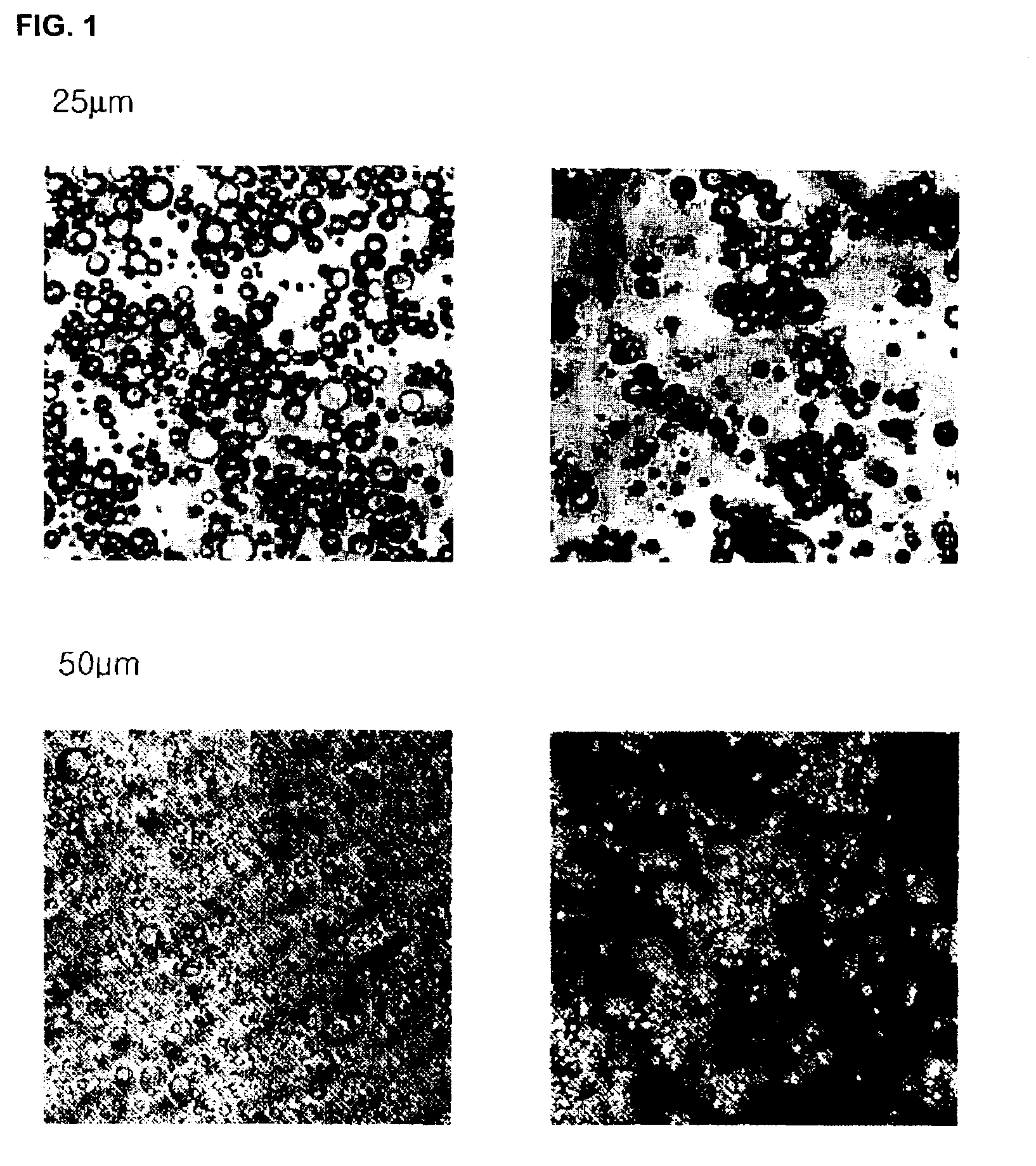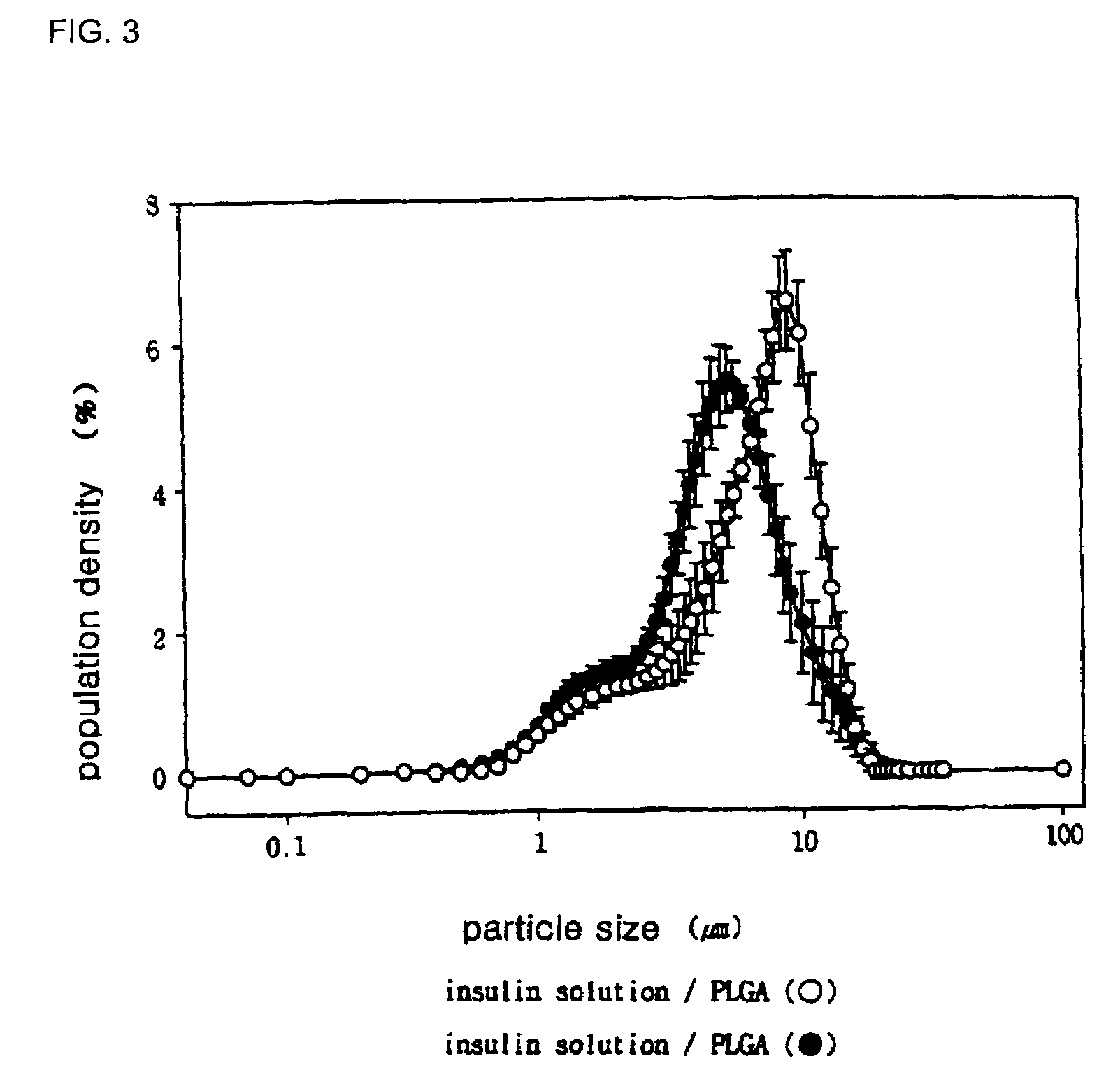Controlled release preparation of insulin and its method
- Summary
- Abstract
- Description
- Claims
- Application Information
AI Technical Summary
Benefits of technology
Problems solved by technology
Method used
Image
Examples
example 1
[0089]Microencapsulation of insulin crystals[0090](1) Insulin powder was dissolved in an acetate solution of pH 2.0 and the acidity of the resultant was varied using 1 N NaOH and 10 N NaOH. Then, when pH became 4.5, aggregates began to be produced. When the pH was further raised up to 6.0, more than 65% of insulin crystals having a diameter of 5 μm or less were produced. If the pH level of the insulin solution of pH 9.0 to 10.5 was sharply lowered to pH 6, more than 90% of insulin crystals having a diameter of 5 μm or less were produced within several seconds to approximately 2 minutes. In such a manner, the insulin microcrystals existing in a solution phase were prepared.[0091](2) The prepared solution phase insulin microcrystals were centrifuged at 4,500 rpm for 15 minutes to remove a supernatant solution and insulin microcrystals were separated.[0092](3) The separated insulin microcrystals were washed with distilled water to remove insulin molecules present in the solution and th...
example 3
[0098]Measurement of size of insulin microparticles
[0099]The microparticles prepared in Examples 1 and 2 were observed using an inverted microscope (Model CK2, Olympus, Tokyo, Japan), the observation result being shown in FIG. 1, and the surfaces of the microparticles were observed by scanning electron microscopy (SEM), the observation result being shown in FIG. 2. Also, the size of the microparticles prepared in Examples 1 and 2 were measured, and the measurement result is shown in FIG. 3. The particle size of the insulin crystals prepared in Example 1 (1) and the microparticles (crystal / PLGA) prepared in Example 1 were analyzed, and the analysis result is shown in FIG. 4.
[0100]FIGS. 1A and 1C are photographs taken by an inverted microscope, illustrating solution / PLGA prepared in Example 2 (×400 and ×200) and FIGS. 1B and 1D are photographs taken by an inverted microscope, illustrating crystal / PLGA prepared in Example 1 (×400 and ×200). As confirmed in FIG. 1, uniform rectangular m...
example 4
[0103]Stability test
[0104]The crystal / PLGA prepared in Example 1 and the solution / PLGA prepared in Example 2 were dispersed in a PBS solution of pH 7.4 and released at 37° C. After being released for 7 days, the resultant was centrifuged to recover a supernatant solution, and analyzed with RP-HPLC, and the results are shown in FIGS. 5C and 5D.
[0105]As confirmed from FIGS. 5A through 5D, deamidated products are observed in both Examples 4 and 5. To get more accurate results, the ratios with respect to the overall insulin peak area are calculated, and cases for non-freeze-dried samples and freeze-dried samples are compared, with the comparison result is shown in Table 1.
[0106]
TABLE 1Sample Insulin (%)Deamidated insulin (%)Non-freeze-solution / PLGA93.17 ± 0.646.83 ± 0.64driedcrystal / PLGA98.74 ± 0.201.26 ± 0.20Freeze-driedsolution / PLGA93.52 ± 3.126.48 ± 3.12crystal / PLGA97.80 ± 0.472.01 ± 0.47
[0107]As shown in Table 1, the crystal / PLGA prepared in Example 1 had a much smaller amount of de...
PUM
| Property | Measurement | Unit |
|---|---|---|
| Length | aaaaa | aaaaa |
| Fraction | aaaaa | aaaaa |
| Acidity | aaaaa | aaaaa |
Abstract
Description
Claims
Application Information
 Login to View More
Login to View More - R&D
- Intellectual Property
- Life Sciences
- Materials
- Tech Scout
- Unparalleled Data Quality
- Higher Quality Content
- 60% Fewer Hallucinations
Browse by: Latest US Patents, China's latest patents, Technical Efficacy Thesaurus, Application Domain, Technology Topic, Popular Technical Reports.
© 2025 PatSnap. All rights reserved.Legal|Privacy policy|Modern Slavery Act Transparency Statement|Sitemap|About US| Contact US: help@patsnap.com



